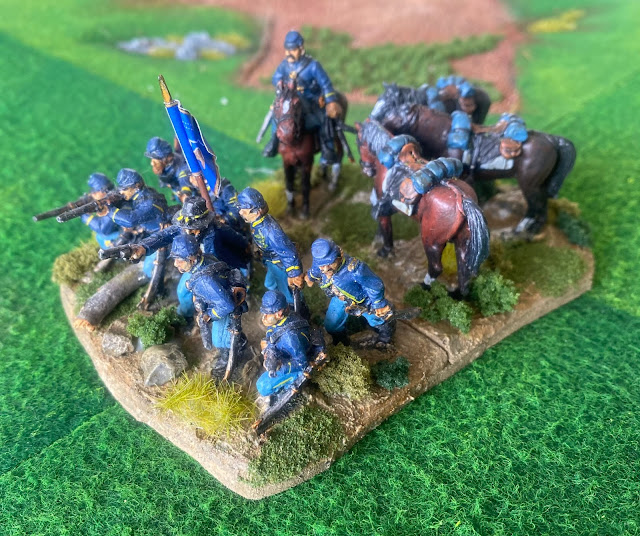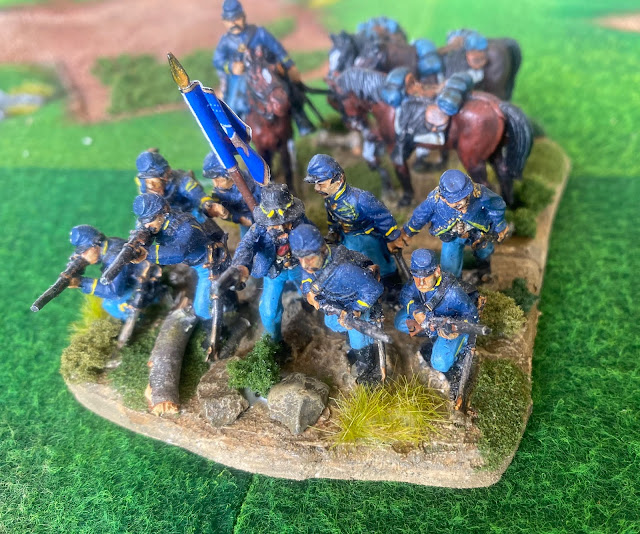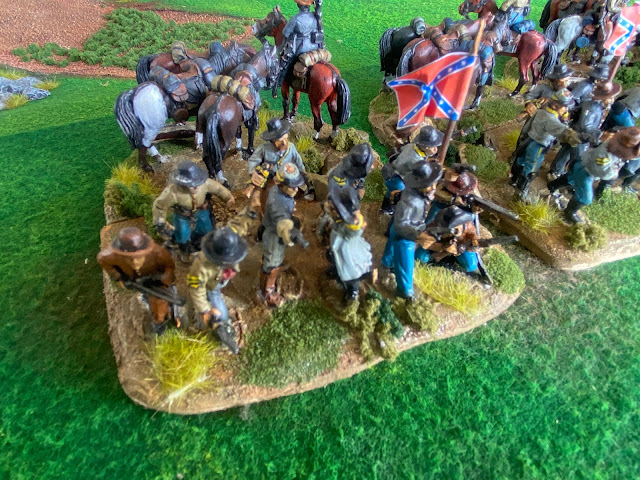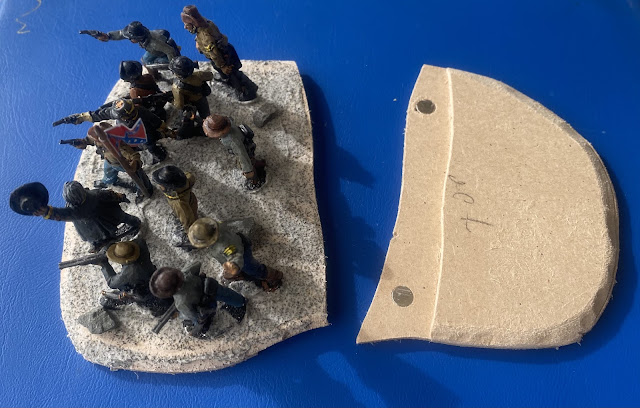I have been back working on some dismounted cavalry for my American Civil War collection that I last worked on nearly eighteen months ago. In fact most of the Confederate troopers were painted before Christmas, but the horse holders only arrived this week.
First is a small Union regiment, the dismounted figures for which were completed long ago, but were left sitting in a box waiting for their horse holders.
Next is a brigade of four regiments of dismounted Confederate cavalry, two standard and two small units.
With these bases I have made the horse holders detachable by making a split base held together a couple of rare earth magnets.
Arguably the best known dismounted cavalry action of the war was Buford’s action on the morning of the first day at Gettysburg. My view of this action has always been the traditionally romantic view perpetrated by the narrative writers of the 1950’s and 60’s with the small cavalry force engaged in a desperate toe-to-toe fight with Confederate infantry that saved the day and was later depicted in the film “Gettysburg”.
A common misconception is that Buford’s troopers were armed with Spencer repeating carbines, but not so. These were not widely issued until after the battle, although a number of Spencer rifles (maybe as many as 350) were in use within three of five regiments of Gamble’s Brigade, or about 20% of his effective strength. The bulk of the division was equipped with breechloading carbines (Sharps, Burnside and Maynard types) with a rate of fire of up to double that of the rifled musket, albeit with a lesser range.
Surprisingly the Official Records is a bit light on detail with regard to Buford’s action. The only reports available from the division were from Buford himself and his two brigadiers, Gamble and Devin. No reports from the regiments are available. Of those three reports none exceeded 50 printed lines. In all cases they speak of skirmishing, falling back in front of a superior enemy, and universally praise the effectiveness of Calef’s horse battery.
Thankfully in addition the Official Records I have solid references on this action, principally Edward Longacre’s two excellent books “General John Buford” and “The Cavalry at Gettysburg”, Harry Pfanz’s “Gettysburg: the First Day”, David Martin’s “Gettysburg 1 July 1863”, Stephen Sears’ “Gettysburg” and Alonzo Guelzo’s “Gettysburg: The Last Invasion”.
The best descriptions are available in the works of Longacre, Pfanz and Martin so I have used them as the basis of my investigation. The story begins when Heth set his Confederate infantry division in motion east towards Gettysburg from its bivouacs around Cashtown (about 12 kilometres from Gettysburg) at 05:00. Pettigrew’s Brigade was in the most easterly bivouac, at McKnightstown three kilometres east of Cashtown, but in the Army of Northern Virginia it was the practice to rotate the advance and it was Archer’s Brigade that was rostered to lead the advance this day. While his starting position is not clear it took an extraordinary amount of time, somewhere between one and a half and two hours, for Archer to form up and pass Pettigrew’s camp. Archer, followed by Pegram’s artillery battalion and then Davis’ Brigade advanced without any particular urgency or caution and without skirmishers deployed.
About six kilometres from Cashtown Buford’s videttes fired the first shot of the battle at 07:30. The fire was a extreme range and caused no loss, but had a big impact on the morning’s action because it caused Archer’s, Davis’ infantry and Pegram’s batteries to deploy. It took between 60 and 90 minutes to complete the deployment so that it was not before 08:30, probably nearer to 09:00, that the advance proper commenced, with a strong skirmish line ahead of the battle line. As the Confederates approached Marsh Creek they encountered the first opposition, but it was hardly serious opposition, just groups of mounted skirmishers, that were quickly forced to retire in the face of the heavy Rebel advance. Some of Pegram’s guns also loosed a few rounds at the Yankee troopers.
Crossing the creek Archer encountered the first dismounted opposition, a thin chain of men spread along the fence lines at distances of 30 feet between men, firing rapidly with their breechloading carbines to give the impression of a larger force. Again this did not deter the Confederates, in fact Colonel Fry of the 5th Alabama Regiment described the cavalry resistance as “inconsiderable”. Nonetheless it slowed the Confederate advance, as did the fire of Calef’s Battery that Buford had deliberately placed in either side of the turnpike to provide a greater spread of fire across the front and possibly to make the force seem greater than it was. Gamble’s and Devins’ skirmishers fired and retired repeatedly first to Herr Ridge, then successively fence line to fence line back to McPherson Ridge where the main line stood. What is not clear is is how that line was formed: whether the regiments were fully dismounted and in what density. It appears to have been a mix of mounted and dismounted troopers.
By 09:30 things were looking grim for Buford. Ammunition was running low and the Confederates extended well beyond his flanks. Calef was compelled to withdraw by degrees back towards the town to avoid losing his guns. Thankfully help was at hand in the form infantry from I Corps that took over the fighting line by 10:00.
The cavalry had done its job having delayed the Rebel advance long enough for the infantry to come into position. Casualties for the morning’s action had been light with Gamble suffering 12 killed, 70 wounded and 28 missing (although this would still have been considered a significant loss for cavalry) and Devin 3, 4 and 13 respectively, a total of 131 for the division.
So it was not the stand up fight as I had always viewed it. It was no more than a heavy skirmish. Even with faster firing weapons, the cavalry were not able to take on infantry in a stand up firefight. What really played into Buford’s hands was that Heth and his brigadiers were in no rush to get into Gettysburg that morning and didn’t push hard. Not until they encountered the infantry of I Corps did the gravity of the situation become clear.
Longacre’s book covers the other cavalry action not only at Gettysburg, but also the flurry of reconnaissance and counter-reconnaissance actions that preceded the battle. All of these actions involved dismounted actions in some form, albeit against other cavalry units and not infantry. At Aldie, Middleburg and Upperville, the three key actions fought in the early part of the campaign both sides used dismounted troops. Similarly the action in East Cavalry Field on 3 July at Gettysburg there was a limited use of dismounted cavalry as skirmishers (of particular note is that one of Custer’s regiments, the 5th Michigan, was armed with the Spencer repeating carbine and used them with effect, holding off the more numerous Confederate skirmishers). At Fairfield, on that same day two squadrons of the 6th US Cavalry attempted to get at the Confederate rear, but was intercepted by Jones’ Confederate cavalry brigade. The 6th dismounted and took up a position behind a fence in front of an orchard successfully drove off the Confederate 6th Virginia, before their flanks were turned by other Confederate regiments. Again, in all of these actions dismounted activity was limited to a skirmishing role.
Gettysburg, of course, was not the only dismounted cavalry action of the war so I began to look at some others. This was not such an easy task for me because my reference depth was not as great. Clearly the list of cavalry actions in the Civil War is extensive and it would be foolish to try to assess them all, but perhaps some selective actions will suffice for my purpose. The ones that I have chosen are Trevalian Station, Cedar Creek, Five Forks, Sailor’s Creek and Brice’s Cross Roads.
Trevalian Station was an all cavalry affair fought over 11 and 12 June 1864. On the first day elements of Hampton’s Confederate cavalry fought against Merritt’s Union troopers in dismounted action in the woods. Again the references are to skirmishing in a heavily wooded area rather than any sort of stand up fight. Custer’s action around the Station itself was dominated by mounted action with charge and countercharge, although the Confederate horse artillery played a significant part in boxing him in and very nearly bringing him to his last stand twelve years early. On the second day the Union cavalry found Hampton in a strong position behind log breastworks the Union cavalry launched a series of unsuccessful and costly dismounted assaults against that position before breaking off the fight.
At Cedar Creek in 19 October 1864, Sheridan placed his cavalry on the flanks, with Merritt’s Division on the left and Custer’s on the right. Reading the official reports of this action the cavalry was entirely mounted and the charge after charge was delivered against the Confederate infantry in concert with the infantry of VI Corps. While not every charge was a success, against the exhausted Confederate infantry the overall effect was devastating, proving that used on mass in open terrain cavalry still had role on the battlefield.
Five Forks, 1 April 1865, provides the best example of dismounted cavalry assaulting Confederate infantry. Here the Union cavalry made first contact mid-afternoon with Devins’ Division in the lead. Stagg’s Brigade established the contact and remained mounted while Fitzhugh’s and Gibbs’ Brigades dismounted and pushed the Confederate infantry back through the woods to their works that were in places only 40 yards beyond the trees. The dismounted attack pushed close to the enemy works, and some of the troopers may have even penetrated the works briefly, but the position was too strongly held and the cavalry fell back to the woods to await expected infantry support to their right. A heavy skirmish developed across the short distance between the woods and the works. Devins instructed the 1st US Cavalry from Gibbs’ brigade to remain mounted in order to exploit any advantage.
Meanwhile Custer’s Division came up on the left of Devins, with Pennington’s Brigade dismounted and the other two brigades mounted. When the infantry attack commenced at 4:30 Gibbs and Fitzhugh joined and Pennington was also drawn into the fight, despite it not being Custer’s intent. The first attack stalled when Pennington’s most right regiment fell back. A second attack also stalled, but the third carried the works and the 1st US Cavalry was unleashed in a mounted charge that gathered 1000 prisoners. At the same time Custer moved his mounted brigades rapidly to the left to gain the enemy’s rear. To cover the movement and to draw the fire of the Confederate artillery he sent the 8th New York Cavalry to make a mounted charge against the guns. The attack was repulsed with a heavy loss, but it did the trick and Custer was able to drive back the Confederate cavalry under Fitzlee, forcing the Confederate line to collapse.
Five days later at Sailor’s Creek the Union cavalry caught up with a portion of the retreating Army of Northern Virginia and attacked Anderson’s Division and the Army’s trains. After initially being driven back Anderson’s infantry recovered and pushed the cavalry back, but a gap had developed between Anderson and the next division in line which Custer exploited, capturing ten guns before Anderson drove him off. Finally to Custer’s left Crook’s Division came into action with Gregg’s brigade dismounted on the left, Davies’ mounted in the centre and Smith’s dismounted on the right, directly opposing Anderson, Johnson and Pickett who had establish a line behind some hastily constructed breastworks. Gregg overlapped and attacked the Confederate extreme right while Smith attacked frontally. When the line was engaged Davies delivered the coup de grace riding his mounted troopers right over the Confederate works causing the defence to collapse.
In these last two actions most of the dismounted action was generally in the form of heavy skirmish lines manned by well trained troopers universally armed with repeating carbines. They became very adept at intercepting and delaying the enemy, but unless supported or able gain the flank generally struggled to make headway against steady infantry and were frequently driven back. As the Confederate retreat continued the tactics of an aggressive combination of dismounted and mounted action against Lee’s demoralised regiments proved extremely effective.
Brice’s Cross Roads, 10 June 1864, was a very different sort of fight. First, because it was in the western theatre. Second, because Bedford Forrest was involved. The action was wholly dismounted. It should be noted that Forrest’s concept of dismounted action was markedly different to his Union counterparts. Forrest did not issue sabres to his troops, but instead had them carry a rifled musket and two revolvers. Similarly he shunned horse holders, preferring to picket the horses rather than remove a quarter of his manpower from the fighting line. His cavalry were for all intents mounted infantry.
The initial conflict was between Grierson's Union troopers and a single brigade of Forrest’s force. Greatly outnumbered the Confederates fought to hold their ground in wooded terrain until reinforcements could arrive. Forrest had his troopers drive forward, then retire, and advance again, keeping Grierson's men on the back foot. A second Confederate brigade came up along with artillery support and their line was extended. Forrest pushed forward, but could not drive Grierson's men back. When a third then a fourth brigade came up Forrest gave the order to attack. Part of Grierson's line was broken, but fresh regiments were in hand to fill the gaps. The Confederates then launched a furious assault across the open fields and after a desperate struggle at very close quarters forced the Union troopers back on Brice’s Cross Roads. At this point the first Union infantry arrived and took over the fighting line. Forrest continued to press the attack, but was repulsed. A Union counterattack was likewise repulsed, at close range by pistol fire.
At that same moment the 2nd Tennessee Cavalry, that had been sent in a broad sweep to the right around the Union left, appeared in the rear of Union position and the line began to crumble. Two regiment of US Coloured Troops were brought forward to stem the retreat, but Forrest ordered a battery of four guns double-shotted and brought them forward to “within pistol range” of the enemy and blasted the Federal troops. The Union line dissolved and when a wagon overturned on the only bridge to the rear the rout began. In the fight and the relentless 60 mile pursuit that followed Forrest inflicted losses of 2,612 on the Union force (out of 8,100 engaged) for his own loss of 493 and captured 250 wagons and ambulances, 18 cannon and thousands of stands of arms.
For anyone interested in the action at Brice’s Cross Roads and excellent little work on it is the National Park Service booklet ‘Protecting Sherman’s Lifeline: The Battles of Brices Cross Roads and Tupelo 1864’ by Edwin Bearss (once the NPS park historian at Vicksburg) be found online here.
So how does all this influence my thinking about how to use dismounted cavalry in my wargames? We have always treated them like mounted infantry, with carbines instead of rifles, yet clearly dismounted cavalry did not fight like infantry. On foot they did not have the tactical adhesion and fire discipline that infantry have. So they need to be treated as skirmishers in most respects but still need to be able to attack.
My plan is to say that all dismounted cavalry will act and fire as skirmishers. In my rules units are rated large, standard, small or tiny and a number of firing dice are allocated to each unit size. Skirmishers are only ever allowed one firing die per unit, whether a single company or an entire unit deployed. Dismounted cavalry will follow this rule, but one exception: where units are entirely armed with breechloading or repeating carbines they can re-roll misses. I also handle casualties to skirmishers differently. They test for hits as normal but do not mark casualties. Instead any unsaved casualty halts the skirmish line. Any two hits in one turn on a halted skirmish line forces it to retire on supports, or back out of small arms range where an entire unit is deployed as skirmishers.
I allow for two types of close action: a charge where one unit tries to break the other with shock action - a bayonet or sabre charge - and an attack that is a more calculated attempt to break the enemy by advancing into close range and driving them off by fire. I do not believe that the charge is appropriate for dismounted cavalry so they can only ever make an attack. In the actual fight (after closing fire) dismounted cavalry are always at a disadvantage against good order troops and will always count the disordered factor in any fight.
How to deal with the Forrest differences? One option is to do nothing - Brice’s Cross Roads had some exceptional circumstances (it was fought heavy terrain and the Union infantry was fatigued by hard marching and arrived piecemeal) and in other large actions Forrest’s tactics were not so successful, so just let dice and chance too their business. However, if changes are deemed necessary the only difference I would suggest is that in an attack his units get to re-roll any misses for closing fire to represent his use of rifles and revolvers.
That is more than enough on this subject.








Mark, this is a fantastic post, very interesting.
ReplyDeleteThanks Norm, it is an interesting subject and deserves more study.
DeleteHandsome basing of your dismounted cavalry and a fascinating look at cavalry tactics. I enjoyed your analysis very much.
ReplyDeleteThank you Jonathan. We used the “new” tabletop tactics in a game today and they worked well.
DeleteThat is a lot of research Mark....interesting stuff .... the cavalry seem to have fought in a similar manner to the Arab mounted archers of the crusader era...fire and retire, albeit more often dismounted. I would imagine they remounted when they needed to pull back a significant distance , half a mile or more, rather than just dashing on foot to the next fence line?
ReplyDeleteYes it was an interesting exercise. The way the cavalry developed made them a highly effective force by the end of the war and set the stage next 25 years in the plains wars.
DeleteAn interesting treatise Mark, showing the value of a comprehensive library. I suppose it comes down to how much granularity you then want to incorporate in the rules or, as you point out, whether you are better to abstract to a greater extent and let the dice do the work. I remember we played a Napoleonic game a couple of years ago where we incorporated weather, ammunition and supply, five or six different types of open terrain which affected visibility, movement and cannon-ball bounce through etc. It felt quite "realistic" and we plugged away at it for two months before we decided it was unplayable.
ReplyDeleteLOL - I can imagine Lawrence! It comes down to this in my opinion - do we want a reasonably "realistic" game that's fun to play....or are we at staff college, trying to recreate battlefield conditions? For my part, I want a game thats fun and aesthetically pleasing......
DeleteIt was a fun bit of research and I love dusting off the books! I think we have all been down that track of too much detail. I try to abstract as much as possible while trying to keep the flavour of the period. One if the biggest faults wargamers have is to read about a single incident and build a case for special rules to cover that incident.
DeleteAnd sometimes the converse is true. I find that in DBMM, a set of rules I quite enjoy, some very gamey things happen and it is always amusing watching the nailed-on DBMM members of our group trying to conjure up historical scenarios to explain how it could have happened.
DeleteVery nice figures Mark and fascinating reading on how they were used in the ACW. I must keep this in mind for my future games.
ReplyDeleteThanks Steve. I have a big cavalry action planned for later in the year that will test the ideas thoroughly.
DeleteLovely toys Mark…
ReplyDeleteA very interesting post indeed… getting a game mechanism gives a good feel of the period and tactics is definitely way better than going down the pedantic details rabbit hole.
I remember playing a game where we had to roll to see how long it took to cross fences and hedges… Realistic… possibly… fun…not with my dice throwing… the hedge won 😁.
All the best. Aly
I remember one of the first set of rules I had was the Skytrex ACW set that I think David Chandler co-wrote. To fire you worked through a number of tactical factors then multiplied that by the number of figures, multiplied by the number of rounds they could fire [based on whether the unit was raw, trained or veteran) within a five minute period, divided by a range factor and the result was the number of casualties and you then divided that by 33 to determine the number of figures removed and recorders the difference. Then if the target was advancing you would apply the number of casualty’s against the units movement rate, reducing the rate by 1mm for every casualty and if the fire was received from the flank that would force a lateral deviation….I think we played them twice.
DeleteLovely touch on the bases, interesting thoughts on how to game them realistically.
ReplyDeleteCheers
Stu
Thanks Stu. I was quite pleasing that the concept worked well in practice too.
Delete